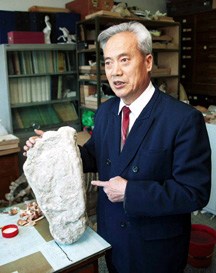Yuan dabbles in stories
of abduction, including those of two farmers who say they were kidnapped by
Bigfoot but escaped to tell the tale. Another person claimed to have spent
two hours in conversation with the creature, who reportedly gesticulated and
mimicked bird sounds.
"They're very clever,"
said Yuan, a retired paleoanthropologist and member of the prestigious Chinese
Academy of Sciences.
Yuan describes Bigfoot
as more than 6 1/2 feet tall, with reddish brown hair, long limbs and a rather
nasty case of body odor.
In 1976-77, the government
sponsored a Bigfoot expedition to Shennongjia consisting of 100 people, including
army personnel.
That trip and others
yielded numerous samples of what Yuan maintains are the hair, footprints and
feces of an undiscovered species, possibly descended from a giant ape whose
fossilized teeth can still be found in the
region.
"They're a cousin of
humans," he said of Bigfoot, known in Chinese as "wild man."
But money for such
study has dwindled, because fewer and fewer of Yuan's fellow scientists are
willing to approve funding without more conclusive proof.
Yuan and his supporters
have been forced to dig into their own pockets to keep three informal research
centers operating. One of Yuan's colleagues even divorced his wife, sold his
home and moved permanently to Shennongjia to carry on the work.
News Article ; December
6, 1999
China tracks red-haired
corn-eating Big Foot
BEIJING, Dec 6 (Reuters)
- Standing 2.5 metres (eight feet) tall, with long red hair and a taste for
corn on the cob, Big Foot is back and apparently running around a nature reserve
in central China, state media said on Monday.
Chinese scientists
are on the trail of the legendary ape-like beast after a hunter reported seeing
a huge fast-moving creature covered in long, red hair in Hubei province's
Shennongjia Nature Reserve two months ago, the China Daily said.
The scientists found
40-cm (16-inch) footprints, brown hair and chewed corn cobs at the spot where
the hunter said he saw the beast, and concluded they were not left by a bear,
it said.
Scientists have unearthed
hundreds of fossilised teeth of giant apes in the area, and some speculate
that Big Foot could be a descendant of such primates, it said.
San Jose Mercury News ; June 25, 1997
CHINESE TEAM HUNTING
A RED-HEADED 'BIGFOOT'
(REUTERS) Researchers
hunting for China's elusive, hairy ''Bigfoot'' may have found footprints of
the legendary creature, the Xinhua news agency said Tuesday.
Hundreds of very large
footprints resembling those of a man -- but much larger-- have been seen in
the forests of the mountainous Shennongjia National Park in central Hubei
province, the agency quoted Wang Fangchen, head of the privately run Committee
for Research on Strange and Rare Creatures, as saying.
''We have made preliminary
conclusions that they were left by two animals walking on two legs,'' it said
quoting Wang, who has been hunting for the fabled creature for several years.
''The biggest footprint
is 37 centimeters (15 inches) long, very similar to that of a man but is quite
larger than man's, and is different from the footprints of a bear or any other
identified animals,'' Wang said.
He said he believed
the creature that made the footprints weighed about 440 pounds.
Wang had led a team
of 30 scientists on a fruitless hunt through Shennongjia last summer. He had
vowed to resume his search for the fabled 6 1/2-foot-tall, red-haired, human-like
creature that is part of local folklore.
Wang's team found similar
footprints left by two other mysterious creatures in Shennongjia last winter,
Xinhua said.
Progress toward unraveling
the myth of the ''wild man'' would be of great scientific significance, Wang
said. But he urged caution and warned researchers not to jump to swift conclusions
without hard scientific evidence.
Theories abound about
the mythical creature, with some scientists speculating that if it exists,
it may be an unknown primate, some arguing that it may be a bear or a monkey
and others suggesting it could be a missing evolutionary link between ape
and human.
Oregonian, May 25,
1995:
Chinese Scientists
will begin a yearlong hunt for Bigfoot
Chinese Scientists
are beginning a yearlong expedition to investigate reports of a 7-foot "Bigfoot"
wandering the wilderness. The 30-member team will explore the Shinnonglia
Nature Reserve in central China, where for centuries residents have reported
sightings of a creature that is half-man and half-ape.
The expedition plans a scientific survey of the region's environment, geography,
and meteorology, even if it fails to find Bigfoot. The nature reserve, in
the western part of Hubei province, is home to rare species, including the
golden monkey. Anthropologists, biologists, and geneticists from the Chinese
Academy of Science, Beijing University, and Beijing Normal University are
taking part in the expedition."
Saturday, August 19th,
1995
San Francisco Chronicle
( From the
"Earth Week" column)
Airborne Search
The world's only government-sanctioned search party for "Big Foot" is gearing
up for a new survey that will link high-tech aerial equipment with observers
on the ground. Earlier searches this summer led by Wang Fangchen, with a 30-member
team from China's Committee for Research into Strange and Rare Animals, failed.
While residents in Hubei province have reported 114 sightings and collected
hair and footprints from the suspected "Abominable Snowman" during the past
40 years, no such evidence was found by the team. They will now deploy balloons
equipped with infrared-sensing instruments 2,000 feet above the forest. "Any
activities conducted by large-bodied mammals would be recorded by the apparatus."
Wang told reporters.
From UPI Wire Service:
August 2, 1988
Legendary 'Wildman,'
cousin of bigfoot, exists
BEIJING·(UPI)
Scientists say an analysis of hair reportedly belonging to China's version
of the abominable snowman has proven the existence of the legendary "Wildman"
that roams southwestern forests, a news report said Tuesday.
The distribution of
trace elements in the Wildman hairs is different from that of modern man,
Black bears, oraneutans and other animals, Shanghai's Wen Hui Bao newspaper
said.
"This objectively proves
the existence of the Wildman, a rare and
advanced primate that is similar to man," it said.
A team of 100 Chinese
researchers headed for the mountain forests of central Hubei Province in June
in an effort to solve the 9,000-year-old mystery of the half-man, half-ape
whom numerous peasants in the area claimed to have seen.
Peasant witnesses speak
of a man-beast at least 7 feet tall with reddish hair and long, swinging arms.
A number have claimed they heard the "Wildman" emit a laugh that sounded almost
human.
Nicknamed "Fei Fei"
by Chinese scientists, the creature is cousin to North America's bigfoot and
the legendary abominable snowman of the Himalayas.
Atomic and chemical
analyses showed the levels of calcium, iron and copper to be higher in the
hair of the "Wildman" compared to nine other mammals, including man, black
bears, golden monkeys and orangutans the report said.
The tests were conducted
by the animal biology department at Shanghai's Huadong Normal University and
at the Shanghai branch of the Chinese Academy of Science. They were done under
the supervision of Liu Minzhuang, a biology professor at the university and
head of the China Wildman Research Center, which was set up in the early 1980s.
In 1985, the association
held an exhibition in the southern city of Guangzhou featuring plaster footprints,
hair samples and droppings alleged to be from the "Wildman".
A year earlier, the
Shennongjia Mountain forest was declared a nature preserve for the man-beast
because of persistent sightings in the area. The "Wildman" has also been reported
seen in the provinces of Sichuan; Shaanxi and Henan, the Guangxi Zhuang Autonomous
Region in the far south and in the Himalayan region of Tibet.
Records of sightings
date back as far as 3,000 years in China. During the 1950s and 1960s, Chinese
scientists searched for the abominable snowman in the Himalayas and for the
"Wildman" in the primitive forests of the Xishuangbanna region of southern
Yunnan Province.
Detroit Free press;
Thursday, March 26, 1981
9-FOOT,
REDHEADED VEGETARIAN STALKS CHINA
By William D. Montalbano
Knight-Ridder Foreign Staff
PEKING - Bigfoot is
a vegetarian redhead.
He stands about nine
feet tall. He strides eight feet with each step of clodhopping, five-toed
feet that measure 19 inches.
He scares some people
and intrigues a great many more. Is he a lost link between man and the apes?
The alleged Chinese
cousin of America's supposed Bigfoot lives in a heavily forested, lightly
populated region of Hubei provence in central China.
The Chinese call him
"ye ren" - wild man. And, being Chinese, they have a five-year plan to track
him down.
Results of the first
summer expedition, now being published in Peking, are intriguing but inconclusive.
More than 250 local folk in northwestern Hubei have sighted ye ren at different
places and different times. However, no one has produced him for an outsider
yet, or for a camera.
Investigators say the
witnesses draw a common portrait: Ye ren is very tall. He has red hair or
fur, no tail, and walks upright.
About 8,000 feet up
the side of Jiongdao Mountain in Hubei, scientists discovered more than 200
footprints. The Chinese press says they are the largest footprints found anywhere
in the world. The tracks show that ye ren walks as humans do, with no sliding
motion, they say.
Hair samples recovered
from trees and brambles are red and fine and resemble human air in their cellular
structure, the scientists say.
From analysis of the
footprint, the hair and the droppings, the scientists have ruled out the possibility
that they are tracking a bear or a [known] ape.
A statesman-poet named
Qu Yuan who lived in the Third century BC in the area where the present search
is being mounted, referred in his verses to "mountain ogres."
A seventh century historian
described a tribe of "hairy men" in the same region, and an 18th century poet
spoke of a creature "monkey-like yet not monkey" in adjoining Shaanxi province.
The witnesses also
are persuasive, according to Liu Minzhuang, a biology lecturer in Shanghai
who has been researching ye ren for more than 20 years and who led last summer's
expedition.
One old peasant told
of being with Nationalist Chinese soldiers who tracked eight ye ren through
thick forests for 10 days in 1947. One was killed and dismembered by the soldiers,
the peasant said, but any record of the incident was lost in the chaos of
the Nationalist-Communist civil war.
In one of the best
documented sightings, five forestry workers said they were able to approach
within a few feet of a tailless creature with reddish fur near Shennongfia
Mountain in May 1976.
This page was assembled by Matt Moneymaker in 2000.
Bigfoot
Field Researchers' Homepage
Submit
a Report, an Article, or Comments.

